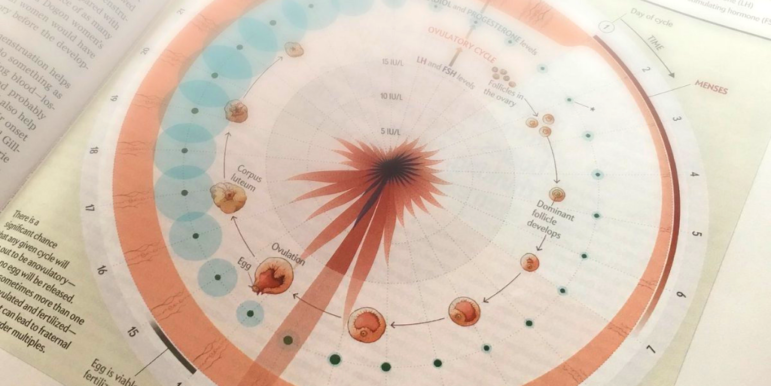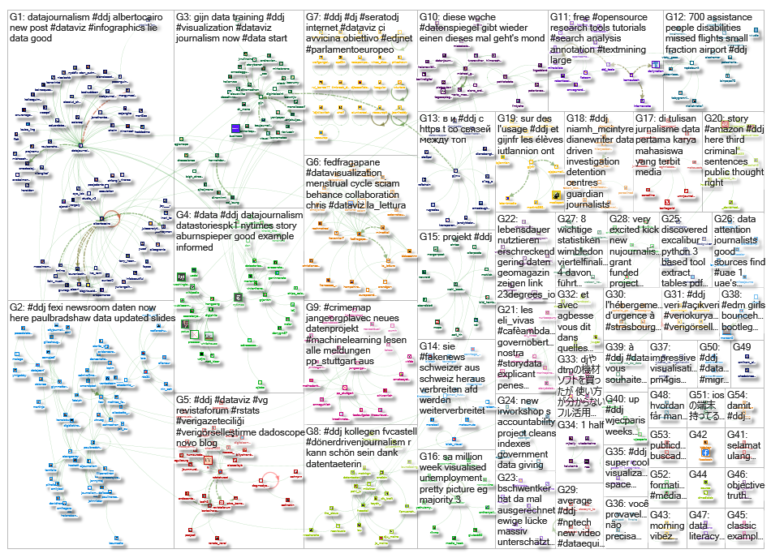

GIJN’s Data Journalism Top 10: Amazon.com, the Menstrual Cycle, Canadian Sex Crimes, Nonsensical Diagrams
What’s the global data journalism community tweeting about this week? Our NodeXL #ddj mapping from July 8 to 14 finds BBC News analyzing Afghan election results and graphing milestones of the 25-year-old Amazon.com empire, Federica Fragapane visualizing the female menstruation cycle for Scientific American, and Bloomberg taking a closer look at China’s domination of the South China Sea. We also have a fun piece by Alberto Cairo on nonsensical diagrams.
Visualizing an Election with No Political Parties
The BBC World Service Visual Journalism team was tasked to cover the 2018 Afghan parliamentary elections last October, the first one held in eight years. Visualizing the results came with a unique set of challenges due to the country’s particular political system. Josh Rayson explains the team’s visualization process in detail.
Let’s Talk Menstruation
Scientific American tackles the topic of female menstruation and dissects how age-old taboos have led to limited research on how women’s cycles work, with serious consequences for their health. It includes a beautiful visualization of the menstrual cycle by Federica Fragapane.
The Amazon Empire
BBC visualized Amazon.com empire’s success in several charts and looks at company milestones over its extraordinary 25-year run.
Dominating the South China Sea
Bloomberg takes a detailed look at China’s “silent war” to dominate the South China Sea and claim contested waters for its own. It maps encounters by fishermen with Chinese vessels and sites of reported clashes, visualizes the Chinese fleet expansion, and more.
https://twitter.com/SiegfridAlegado/status/1149219555975168000
Nonsensical Diagrams
Need a good laugh? Dataviz guru Alberto Cairo gathered some nonsensical diagrams in a blog post, with some choice picks from the PhD dissertation of Sebastian Gorka, President Trump’s expert on “radical Islamist terrorism.”
Data Gaps in Canada’s Sexual Crimes
The Globe and Mail, through the use of Freedom of Information requests, analyzed how Canada’s 22 largest public transit systems track and handle sexual misconduct. It found that the record-keeping, which included incidents on buses, trains and subways, had troubling data gaps and omissions.
E-Scooters in Berlin
Thousands of e-scooters are available for rent in Berlin by four main providers. rbb|24 analyzed the data to determine how this has influenced traffic in the region. Find the data on Github. (In German.)
UAE Open Data
The UAE Government runs an official open data portal, where you can find government data on food security, the economy, the environment, government, and more. (For advice on covering the UAE, don’t miss GIJN’s guide on human trafficking in the Gulf states.)
Emergency Shelter in France
Rue89 Strasbourg mapped the existing emergency housing for the homeless, asylum seekers, and refugees in Strasbourg, France, and highlighted the problems of adequately allocating these emergency shelters for the intended recipients.
Use of Pesticides in France
Mediapart dove into unpublished data by the French Agency for Biodiversity and mapped the use of pesticides in Brittany, France. It also highlighted issues with the use of cooperative models in the agriculture sector. (In French.)
Thanks, once again, to Marc Smith of Connected Action for gathering the links and graphing them. The Top Ten #ddj list is curated weekly.
 Eunice Au is GIJN’s program coordinator. Previously, she was a Malaysia correspondent for Singapore’s The Straits Times, and a journalist at the New Straits Times. She has also written for The Sun, Malaysian Today and Madam Chair.
Eunice Au is GIJN’s program coordinator. Previously, she was a Malaysia correspondent for Singapore’s The Straits Times, and a journalist at the New Straits Times. She has also written for The Sun, Malaysian Today and Madam Chair.










